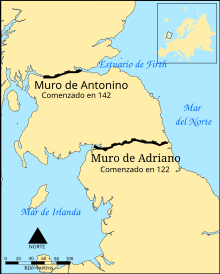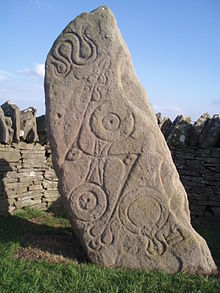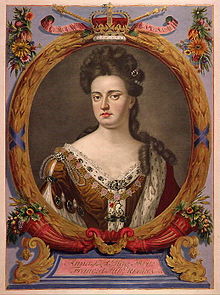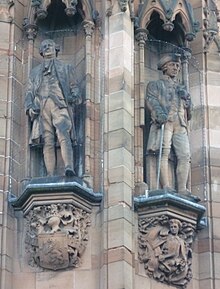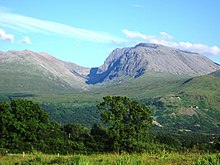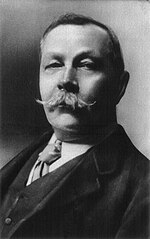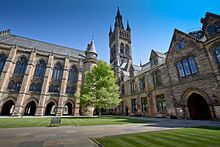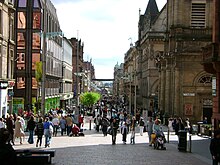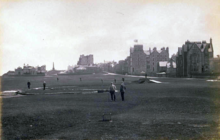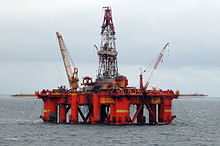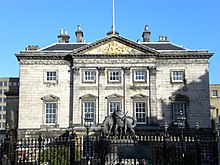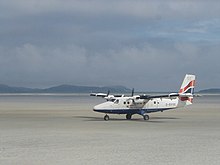Scotland
Scotland (in English, Scotland; in Scots, Scotland; in Scottish Gaelic, Alba) is the northernmost of the four countries that make up the United Kingdom. Along with England and Wales, it is part of the island of Great Britain, covering a third of its total area; It also consists of more than 790 islands, about 40 inhabited. It limits to the north and west with the Atlantic Ocean; to the east with the North Sea, to the south with England and to the southwest with the North Channel and the Irish Sea. Scotland's territory covers 78,772 km², and its population was estimated at 5,479,900 in 2021, giving a population density of 67.5 inhabitants per km². The capital is Edinburgh, while Glasgow is the largest city and its metropolitan area concentrates 40% of the total Scottish population. The area of Glasgow and Edinburgh as a whole is dominated by the central belt (The Central Belt in English).
Scotland takes its name from "Scotus", a Latin term meaning "Irish", whose plural form is "Scoti", "Irish". This refers to the Gaelic migration from Ireland, a country that the Romans initially called " Scotia", the feminine form of "Scotus". The Irish who migrated to present-day Scotland were known as "Scoti". The Romans of the High Middle Ages used the name "Caledonia" to refer to present-day Scotland.
The Kingdom of Scotland was an independent state until 1707, when the Act of Union with England was signed to create the Kingdom of Great Britain, since the union of the crown, or monarchy, already took place in in 1603. The union did not imply an alteration of Scotland's own legal system, which since then has been different from that of Wales, England and Northern Ireland, which is why it is considered in international law as a different legal entity. The survival of their own laws, and of a differentiated educational and religious system form the "sacred trinity" (or Holy Trinity in English) and represent an important part of Scottish culture and its development over the centuries.
Emerging in the 19th century, Scottish independence has gained influence since the late XX; represented by the Scottish National Party which advocates Scottish independence and won an absolute majority in the Scottish Parliament in the May 2011 elections. In 2014, the Scottish government and David Cameron's Conservative government reached an agreement to raise a referendum on Scottish independence that was held on September 18 of that same year, winning continuity in the United Kingdom by 10.6 points (55.3% of the population voted against independence, 44.7% in favor).
Etymological origin
The Anglo-Saxon Chronicle of the X century is the oldest document in which the term Scotland, formed from the Latin term Scoti, of doubtful origin, used as a reference to the inhabitants of Hibernia (present-day Ireland). The word Scotia, which appeared in Vulgar Latin, was used only to refer to the area of Scotland where Gaelic was spoken; Furthermore, this term alternated with Albania, from the Gaelic word for Scotland: Alba. The use of the word "Scotland" to refer to the entire Scottish territory only became widespread in the late Middle Ages. In modern times the term Scot is applied to all the inhabitants of Scotland, regardless of their ethnic origin, since Scottish identity is primarily civic and not ethnic or linguistic. The term scots is also used to refer to the Scottish language, spoken in parts of the Scottish Lowlands and the east coast as far as the islands of Shetland and Orkney.
National symbols
The flag of Scotland or The Saltire consists of a white cross or Saint Andrew's cross on a blue background, an emblem that also became part of the flag of the United Kingdom or Union Jack in 1606. There are many other symbols of Scotland, official or not, such as the thistle (the national flower), the Declaration of Arbroath, the tartan pattern, related to the Scottish clans, or the flag of the &# 34;Rampant Lion" which appears on the Royal Banner of Scotland. The national motto is Nemo me impune lacessit, which can be translated as "No one offends me with impunity", and which in turn is related to the thistle.
The song Flower of Scotland is popularly considered Scotland's national anthem, competing with Scotland the Brave. The former is the one used at most political and sporting events, such as Scotland national football team matches, while the latter is used to represent Scotland at the Commonwealth Games. Since there is no official anthem, the dispute remains open, especially after the 1998 Devolution of Powers, and there are other candidate songs, such as Scots Wha Hae (considered by many to be the official anthem), A Man's A Man for a'That (written by national poet Robert Bruns in 1785) or, more recently, I'm Gonna Be (500 Miles).
Scotland's national holiday is "St. the national poet, Robert Burns, has a larger following. On "Tartan Day" It is another celebration of recent invention, and originating in Canada and in Scotland they are hardly observed. In 2007, the Scottish Parliament approved the official decree by which St Andrew's Day (St Andrew's Day in English) became a bank holiday, an official holiday.
History
Prehistory
It is unknown if Scotland was inhabited during the Palaeolithic period, since the successive ice ages that covered its current territory could have destroyed all evidence of human settlements prior to the Mesolithic period. The first groups of hunter-gatherers are believed to have arrived around 11,000 years ago, when the ice sheets from the first ice age began to retreat northward. The first settlements appeared in the Scottish territory approximately 9,500 years ago, and the first towns about 6,000 years ago. For example, the settlement of Skara Brae and Maes Howe, in the Orkney Islands, which is in a very good state of conservation, dates from this period., as well as other remains of houses, burials and ritual centers of the Neolithic found mainly in the Scottish islands. This abundance of buildings that have survived the passage of time may be due to the absence of trees in the area, which allowed the primitive settlers to create buildings in the local rock itself.
Romanization of Scotland
The written history of Scotland begins with the Romanization of south-central Britain, as present-day Wales and England, which formed the province of Britannia. The Romans initially called Scotland Caledonia ("Land of Caledonios") after the vast forest of Caledonian pines that stretched from north to south and east to west across the country. The main people settled at that time in the Scottish region were the Picts, so called, apparently, because of their habit of painting their bodies. The Scotti, for their part, were a people of Irish origin, also known as the Dalriadas, who settled in western Scotland. During this period there were therefore two distinct kingdoms: that of the west of Scotland, Scotia, and the Pictish kingdom of the east, Alba.
The Romanization of Scotland was a long process with many interruptions: in the year 83, the general Cnaeus Julius Agrícola defeated the Caledonians in the battle of Monte Graupio, which allowed the construction of a chain of fortifications known as Gask Ridge, near the Highland fault, further north, as witnessed by the Roman fort at Cawdor; soon after, however, the Romans withdrew to the Southern Uplands (“Southern Plateaus”), that is, the southernmost third of Scotland, and began the construction of Hadrian's Wall to control the tribes in the area. This line marked for almost the entire period of Roman occupation the northern limit of the Roman Empire, despite the construction, even further north, of the Antonine Wall. This border could only be defended during brief periods, of which the latest took place between the years 208 and 210, during the mandate of the emperor Septimius Severus. Subsequently, the Roman province of Valentia was created in the territory. In total, the occupation of these parts of Scotland by the Romans lasted for no more than forty years, although the Latin influence in the southernmost part, especially among the tribes of British origin, was more lasting.
Medieval history
The kingdom of the Picts, based in Fortriu around the VI century, experienced significant development during the Middle Ages, perhaps as a response to Roman imperialism itself. An important milestone in this struggle for survival and enlargement was the Battle of Dunnichen (685), in which the Picts defeated the Northumbrian tribes during the reign of Bridei III (671 -693). The reign of Oengus I (732-761) was also a period of consolidation for the Pictish kingdom. of the Scotti during the reign of Alexander I (1107-1124). However, already in the X century, the Pictish kingdom was dominated by a culture of Gaelic origin, establishing the myth of the Irish descent from the royal dynasty of Cináed mac Ailpín (Kenneth MacAlpin or Kenneth I). In the following centuries, departing from its original territory in eastern Scotland, north of the Firth of Forth and south of the River Oykel, the kingdom Picts managed to control the northern and southern lands. By the end of the 12th century, the kings of Alba had added to their territory the English-speaking area of south-east Scotland and also dominated the Galloway and Caithness areas; by the end of the 13th century, this kingdom had expanded to roughly the extent of present-day Scotland.
However, certain cultural and economic processes beginning in the XII century would make Scotland during the Late Middle Ages acquired quite different traits. The main impetus for this transformation came during the reign of David I of Scotland, which started what is known as the Davidian Revolution. This is the time when feudalism was introduced in Scotland, the forms of government were reorganized and the first cities and towns with their own charters (the so-called burghs) were founded. These institutions, as well as the immigration of French and Anglo-French knights and clergy, facilitated a process of "cultural osmosis," during which the southern and coastal territories of the Kingdom of Alba became English-speaking, as already many of the newly conquered lands in the south were; the rest of the kingdom, on the other hand, continued to preserve the Gaelic language.
The death of Alexander III in 1286, followed by that of his granddaughter Margaret I, broke the line of succession of the reigning dynasty. This led to the intervention of Edward I of England, known in popular history as The Hammer of Scots, who put his protégé John of Balliol on the throne. As their relationship deteriorated, there was an attempted conquest by England, which was rebuffed by William Wallace—the character popularized in Hollywood movies like Barveheart—in the Scottish Wars of Independence. For his part, Robert the Bruce, Earl of Carrick, proclaimed himself King of Scotland under the name of Robert I of Scotland. The war with England lasted several decades and the Scots often remember their three victories in the battles at Sterling Bridge in 1297, at Lauden Hill in 1307, and above all at Banokburn in 1314. The civil war between supporters of the Robert the Bruce, who claimed descent from David I, and supporters of the Balliols, supported by England, lasted until the middle of the century XIV. Although the Bruce dynasty was victorious, his son David II's absence of descendants allowed his nephew, Robert II, to ascend the throne and place the Stuart dynasty on it. The Stuarts ruled Scotland for the rest of the Ages. Media, a period of prosperity from the end of the 14th century through the Renaissance to the Protestant Reformation. Despite this, the struggles with England continued, as well as the internal division between the Highlands or Highlands and the Lowlands or Lowlands.
Modern history
Modern Ages opened in Scottish history with the Rough Wooing or "violent courtship" (1544-1551), a series of intermittent military offensives through which England tried to force a marriage between Mary I Stuart and Edward VI of England, an objective that was ultimately not achieved. Furthermore, the 16th century is the century of the Protestant Reformation which was more radical in Scotland than in England. In Scotland it was headed by figures like John Knox and supported from England.
In 1603, James VI of Scotland and I of England inherited the throne of England and became James I of England. However, with the exception of a brief period known as the "Protectorate," Scotland remained an independent state, albeit rocked by constant clashes between the crown and the Covenanters, over the form of government of the Church. Following the Glorious Revolution and the overthrow of the Catholic James VII of Scotland by William III of England and his wife Mary II (1688), Scotland threatened to elect a Protestant king other than England's. In 1707, however, following threats the English to close trade with Scotland, the Act of Union was signed, certifying the creation of the Kingdom of Great Britain.
Despite this unification of the two kingdoms, the defenders of the House of Stuart, known as Jacobites, continued to have influence in the Highlands and in the north-east of the country, especially among non-Presbyterians. However, the Jacobite risings of 1715 and 1745 failed to remove the House of Hanover from the British throne. These uprisings also served as an excuse for the massive displacement of the inhabitants of the Highlands or Highlands, in what is known as the Highland Clearances.
Scottish Illustration
The Enlightenment or Scottish School was a cultural movement of the XVIII century characterized by outstanding intellectual, scientific, and cultural production developed in Scotland, especially from the second half of the century. Usually seen as a Golden Age in the history of Scotland, this movement meant the cultural emergence of the Scots, internationalizing and making Scotland one of the main cultural centers of Europe.
Among the outstanding products of this movement are achievements in philosophy, economics, geology, engineering, and sociology. Some of the major figures of the Scottish Enlightenment included the philosophers David Hume, Francis Hutcheson and Thomas Reid, the economist and philosopher Adam Smith, the anthropologist Lord Kames, Adam Ferguson, John Playfair, the chemist Joseph Black, the geologist James Hutton, the engineer James Watt and linguist Lord Monboddo.
Industrial Revolution
Following the Enlightenment and the Industrial Revolution, Scotland became one of the commercial, intellectual and cultural centers of Europe. Glasgow and Edinburgh, in particular, developed rapidly in the late 18th century and during the 18th century variant:small-caps;text-transform:lowercase">XIX, with the tragic parenthesis of a great famine (1846-1857) consequence of the same plague of late blight (phytophthora infestans) that caused the great Irish famine (1845-1849). This event, which mainly affected the highlands, caused a great emigration, despite which a heavy industry of shipbuilding arose on the banks of the River Clyde that transformed Glasgow into the "Second city of the British Empire& #3. 4; after London.
The situation worsened after the First World War, in which large numbers of Scots died, mainly from the Highlands, but especially after the Second World War, after which Scotland's economic situation worsened considerably. rapidly with the disappearance of a large number of industries that were no longer competitive in the international market. Only in the last decades of the XX century the country managed to point to an economic and cultural recovery, thanks to the emergence of new financial services and the electronics sector (in what is known as Silicon Glen), as well as the benefits of oil and gas from the North Sea.
Independence movement
On March 1, 1979, the Scottish referendum of 1979 was held, which was the first popular consultation for the reinstatement of the Scottish Parliament (own legislative chamber), after its integration into the British in 1707. The affirmative answer (51, 6% in favour, 48.4% against) did not obtain the supermajority needed to validate that proposed Scotland Act 1978.
On 11 September 1997, the 1997 Scottish referendum was held to consult the Scottish public on what became known as the "return" of Parliament. The result was affirmative and the following year the Scotland Act of 1998 would be promulgated, by which the Government of the United Kingdom granted greater levels of sovereignty to Scotland, reestablished the Scottish Parliament, allowed them to have their own government and returned to Edinburgh, symbolically, the Stone of Scone. However, it still stood as a constituent nation and administrative region of the United Kingdom of Great Britain and Northern Ireland.
On September 18, 2014, another referendum was held, to decide whether Scotland should be an independent country from the United Kingdom. Following an agreement between the Scottish Parliament and the UK Parliament, the formal question for this referendum was: Should Scotland be an independent country? Yes or No. The result of the consultation obtained 55.3% of the votes for "No". A few days before the referendum took place, some polls indicated a small advantage for the "Yes". However, the results of the referendum held on June 23, 2016 on the permanence or not of the United Kingdom in the EU have once again raised the option of a new plebiscite on the independence of Scotland because, unlike England and Wales, the majority vote in this region was in favor of remaining within the European Union.
Government and politics
Since Scotland is one of the constituent countries of the United Kingdom, the Scottish head of state is the British monarch, that is, King Charles III of the United Kingdom since 2022. In Scotland, the king uses the title King Charles ("King Charles") instead of "Charles III".
Constitutionally, the UK is a unitary state with a sovereign Parliament and government. Following the decentralization of powers approved in a referendum in 1997, Scotland enjoys limited self-government: the British Parliament continues to retain the ability to reform, change, extend or abolish the Scottish system of government at will, so the Scottish Parliament can be considered it is not really sovereign.
The executive power of the United Kingdom rests with what is legally called the King-in-Council ("The King and his advisers"), while the legislative power is held by the King-in Parliament ("The King and Parliament"). In political practice, executive power is held by the UK Government, headed by the Prime Minister, and legislative power, by the UK Parliament. Under the devolutionary regime, certain areas of the legislative and executive have been transferred to the Scottish Government and the Scottish Parliament, in Holyrood, Edinburgh. The Parliament of the United Kingdom, for its part, maintains its power over taxes, social security, the military, international relations, the media and other areas explicitly indicated in the Scotland Act of 1998 as "reserved matters".
The Scottish Parliament has legislative authority for all areas related to Scotland, even to vary taxes slightly, although it has never exercised such power. It can also refer matters relating to returned powers to the UK Parliament, for consideration under UK law as a whole. In certain matters, Scottish legislation has opted for different solutions to those adopted in the state as a whole: for example, university education and care for the elderly are free for residents of Scotland and European community members, while in the rest of the Kingdom United Kingdom, fees must be paid for the same services. Scotland was also the first country in the UK to ban smoking in public spaces.
The Scottish Parliament is unicameral, and is made up of 129 members, 73 of whom represent an electoral district or constituency, and are elected by the single-member majority vote system, the remaining 56 members they are elected in only eight electoral districts, through the proportional representation system; Elected positions have a duration of four years. Following the election of Parliament, the Parliament nominates one of its members to be appointed First Minister of Scotland or Prìomh Mhinistear na h-Alba) by the King. The first Chief Minister of the new parliament appointed in 1999 was Donald Dewar. The rest of the ministers are also proposed by Parliament and approved by the king, and form, together with the main minister of Scotland, the Government of Scotland, that is, the Scottish executive branch.
In the 2011 Scottish Parliamentary election, the Scottish National Party (SNP) won an absolute majority, unlike the 2007 election where the SNP won a simple majority leading a minority government. Scottish National Party leader Alex Salmond was re-elected as Scotland's Chief Minister, retaining the position after winning it at the 2007 election. In 2014 Salmond was succeeded by Nicola Sturgeon. In the 2016 Scottish Parliamentary elections, the Scottish National Party (SNP) lost an absolute majority, although it managed to lead a minority government. Scottish National Party leader Nicola Sturgeon was re-elected Scotland's Chief Minister.
Other parties represented in the Scottish Parliament include Labor with 24 seats, the Conservative Party with 37 seats, the Conservatives with 31, and the Liberal Democrat Party with 5 seats. The Scottish Green Party, co-led by Patrick Harvie, Maggie Chapman, Hap and Dona has 7 seats.
Scotland is also represented in the UK House of Commons, with 59 representatives elected based on Scottish constituencies. The Scotland Office or "Scotland Office", directed by the Secretary of State for Scotland, is the department of the British Government dedicated to dealing with matters related to Scotland. Since May 2010, the post of Secretary of State for Scotland has been held by Michael Moore.
Administrative divisions
The historical divisions of Scotland are diverse, including counties, duchies, burghs (independent cities with representation in the Scottish Parliament) and parishes. A division into regions and districts was put into operation in 1975 but was abolished in 1996. Since then Scotland has been divided for administrative purposes into 32 council areas, or "councils", administered by a unitary authority responsible for all local services. The Community councils ("community councils"), for their part, are informal organizations that represent certain subdivisions within the council.
There are other subdivisions other than Scotland for different purposes. Thus, until April 1, 2013, the fire and police systems were still based on the division into regions introduced in 1975. For the health system, for the postal districts as well as for other governmental and non-governmental organizations, the diverse geographical subdivisions with a long tradition.
City status in the United Kingdom is determined by a royal patent. There are seven cities in Scotland: Aberdeen, Dundee, Edinburgh, Glasgow, Inverness, Stirling, and Perth.
Law
Scottish law is based on Roman law, combining elements of both civil law, which can be traced back to the Latin Corpus Iuris Civilis, and common law, which originated in the Middle Ages. The 1707 treaty of union with England guaranteed the continuity of two distinct legal systems in Scotland, and in England and Wales. Udal", in force in the Orkneys and the Shetland Islands, and which was derived from the old Norwegian legal system. Other legal systems were instead derived from Celtic law or Brehon law, and remained in force until the 19th century. Scottish Law has, on the other hand, a peculiarity that makes it unique, by including a third possible verdict in addition to "not guilty" or "guilty": that of "not proven".
Scottish law establishes three types of courts responsible for administering justice: civil, criminal and heraldic courts. The highest level of administration of civil justice is the Court of Session, although civil appeals may be made to the UK House of Lords. The High Court of Justiciary, for its part, is the highest criminal court. Both are located in Parliament House, the former location of the Scottish Parliament. The main civil and criminal instance however are the sheriff courts: there are 49 active sheriff courts in Scotland. The District Courts were created in 1975 for minor offences. Finally, the Court of the Lord Lyon regulates heraldic law.
Geography and natural history
Scotland occupies roughly the northern third of the island of Great Britain, northwest of the European mainland. In total, its territory covers 78,772 km². Scotland's only mainland border is the one that joins it to the south with England, and which measures around 96 km, between the River Tweed on the east coast and the Fjord of Solway in the western. The Atlantic Ocean surrounds the north and west of Scotland, while to the east lies the North Sea. Ireland is just 30 km from the Kintyre Peninsula, while Norway is 400 km to the northeast, the Faroe Islands 310 km and Iceland 798 km to the northwest. The geographic center of Scotland, traditionally, is located a few kilometers from Newtonmore, in Badenoch, to the north of the most populated areas, although there are different opinions on the matter, depending on the method used for the measurements, or if they are taken into consideration or not the Scottish islands.
The current territorial extent of Scotland is very similar to that established in the 1237 Treaty of York between England and Scotland and in the 1266 Treaty of Perth between Scotland and Norway. There are some exceptions: the Isle of Man, formerly Scottish territory is now a British Crown Dependency; the Orkney and Shetland islands were acquired from Norway in the 15th century; while Rockall, a small rocky islet in the Atlantic, was annexed first to the United Kingdom and later to Scotland by the Rockall Island Act of 1972. However, the legality of this annexation has been disputed by Ireland, Denmark and Iceland, and probably has no effect. in international law.
Geology and geomorphology
All of Scotland was covered by ice during the Pleistocene ice ages, which has major consequences for its landscape. From a geological point of view, Scotland is subdivided into three zones: the Highlands and the islands lie to the northwest of the Highland fault, which runs from the Isle of Arran to Stonehaven. This part of Scotland is composed mainly of ancient rocks from the Cambrian and Precambrian periods, which were uplifted during the subsequent Caledonian Orogeny. This rocky base is crisscrossed by multiple igneous intrusions from more recent times, the remains of which have formed mountain massifs such as the Cairngorms or the Cuillins on Skye. A significant exception to this is the sandstone strata known as Old Red Sandstone, in which fossils have been found, especially around Moray Fjord. The Highlands are generally mountainous and are divided by the Great Glen or "Great Valley". The highest elevations in the British Isles are found here, including Ben Nevis, the highest peak, with an elevation of 1,344 metres. Scotland consists of more than 790 islands, divided into four main groups: Shetland, Orkney, and Hebrides, which are further divided into the Inner and Outer Hebrides. In addition, in this area there are numerous sources of fresh water, including Loch Ness or Loch Lomond. Parts of the coastline consist of machair, a type of terrain consisting of grass-covered dunes.
The land known as Central Lowlands or also Central Belt is a tectonic rift composed mainly of Paleozoic formations. Some of the sedimentary strata in this area have been of great economic importance, since they contain the coal and iron on which the Scottish Industrial Revolution was based. This area has experienced intense volcanic activity, as evidenced by Arthur's Seat, a peak near Edinburgh that is the remnant of a higher volcanic cone that was active during the Carboniferous period some 300 million years ago. Also known as the Midland Valley, this area is relatively flat, although there are abundant hills such as Ochil Hills or Campsie Fells.
The southern plains or Lowlands are made up of a series of hills about 200 km long, alternated with wide valleys. They lie south of a second fault line that runs from Stranraer to Dunbar. This area is mainly composed of Silurian deposits, 400 or 500 million years ago.
The faults, valleys or glens that cross Scotland from east to west are often home to lochs or lochs, such as Loch Ness (the deepest lake in the UK), which sits in the Great Glen, or Loch Lomond (the UK's largest freshwater lake), on the Highland fault line. In addition, Scotland is also crossed by rivers that flow into the Atlantic Ocean or into the North Sea, often giving rise to fjords at their mouths, such as the Firth of Clyde, the Firth of Forth, or the Firth of Tay. The longest rivers in Scotland are the River Tay (193 km), the Spey (172 km), the Clyde (171 km) and the Tweed (156 km).
Climate
Scotland's climate is temperate and oceanic, and tends to be highly variable. It is tempered by the Gulf Stream coming from the Atlantic Ocean, and for this reason it has much milder winters and also the summers are more temperate and humid than in other areas of similar latitude, such as Oslo, Moscow or Alaska. However, temperatures are generally cooler than in the rest of the UK: the country's lowest ever recorded temperature is -27.2°C (–16.96°F) recorded at Braemar in the Grampians, on February 11, 1895 and January 10, 1982, as well as at Altnaharra in the Highlands on December 30, 1995. Winter highs are around 6 °C (42.8 °F) in the Lowlands, and summer highs average 18 °C (64.4 °F). The highest temperature on record reached 32.9 °C (91.22 °F) at Greycrook in the Scottish Borders on 9 August 2003.
In general, the Scottish west is warmer than the east, due to the influence of ocean currents, and the cooler temperatures of the North Sea. Tiree, in the Inner Hebrides, is one of the sunniest places in the country, having 329 hours of sunshine in May 1975. Rainfall varies greatly across Scotland. The western Highlands is the rainiest area, with more than 3,000 millimeters per year. The city of Glasgow, for example, has approximately 170 rainy days per year. By contrast, much of Scotland receives less than 800 mm. Snowfall is rare in the Lowlands, but is common at higher altitudes. Braemar experiences an average of 59 days of snow per year, while coastal areas average less than 10 days.
Fauna and flora
Scotland's fauna and flora is typical of northwestern Europe, although several large mammals such as brown bears, wolves, aurochs, tarpans, lynxes, beavers, reindeer, elk and walrus they were hunted to extinction in historical times. There are still significant populations of seals and nesting grounds for seabirds, such as the common gannet. The golden eagle is almost a national symbol, along with the white-tailed eagle, the osprey or the royal kite, which have recently been reintroduced. in Scotland after being hunted to extinction.
A population of Plectrophenax nivalis flocks to the highlands of Scotland in summer, where partridges, hares and stoats can also be seen in winter in their winter fur. Certain pine forests are still preserved where they inhabit the Loxia scotica, the only bird endemic to Great Britain; the same habitat is also conducive to capercaillie and black grouse, bobcat, red squirrel and marten.
It is worth mentioning, due to its great worldwide diffusion, the contemporary legend of the Loch Ness monster, related to cryptozoology and pseudoscience (and fed as a tourist attraction by local authorities).
The flora of the country is very varied, with an abundance of deciduous and coniferous trees and species typical of the páramo and tundra. However, large-scale commercial planting of non-native coniferous species, and the use of the northern moors for livestock rearing and sporting activities (mainly deer and grouse hunting), have had a major impact on the distribution of native species of plants and animals. A tree located in Perthshire, the Fortingall Yew, a specimen of European yew between 2,000 and 5,000 years old, is probably the oldest living thing in Europe and certainly the United Kingdom. The national flower is the thistle, which appears on the Coat of Arms of the United Kingdom and which can also be symbolically related to the motto of Scotland, Nemo me impune lacessit.
Culture
Over the centuries, Scottish culture has been shaped by an amalgamation of different elements. There is an important artistic activity, both musical and dramatic and literary, strongly influenced by traditional Scottish sources, although it is also open to external influences, especially European ones. Music occupies an important place in Scottish culture. The most notable traditional Scottish instrument is the bagpipe, particularly the Highland bagpipe, a wind instrument consisting of one or more sound tubes fed by an air reservoir contained in a bag. The Clàrsach or Celtic harp, fiddles and accordion are also traditional Scottish instruments, especially the last two, which are part of a typical band for traditional Scottish dances. Scottish emigrants brought many of these traditional forms of music with them, which influenced their host countries, for example American country music. A significant folk music movement continues in Scotland today, both in bars and pubs of the country as well as international festivals, for example Celtic Connections.
In the modern music scene, there are many bands and artists from Scotland, such as Simple Minds, Annie Lennox, Belle & Sebastian, Primal Scream, Decon Blue, Travis, Biffy Clyro, Franz Ferdinand, Texas, or Snow Patrol.
National television is BBC Scotland (BBC Alba in Gaelic), which is part of the British Broadcasting Corporation, the UK's public channel. In addition to two television channels, the BBC also owns national radio channels: BBC Radio Scotland and BBC Radio nan Gaidheal, among others. The main private television stations in Scotland are STV and Border Television. There are also specific Scottish newspapers, such as the Daily Record, The Herald (published in Glasgow) or The Scotsman. Local or regional newspapers include The Courier, published for Dundee and the east of Scotland, and the Press and Journal, for Aberdeen and the north.
The traditional Scottish garment is the kilt, the misnamed “scottish kilt” —a term that offends some Scots.[citation needed] The kilt is usually made of wool, with a tartan design associated with a particular clan or Scottish family name. Many Scots receive a kilt at a very young age., and will use it on special occasions, such as weddings, baptisms, communions... The kilt wraps around the waist, and covers the lower part up to the knees; Furthermore, since it has no pockets, it can be complemented with a special bag called a sporran. Contrary to popular belief that under the kilt you should not wear underwear to be a true Scotsman, the truth is that there is no established rule in this regard.[ citation required]
Language and Literature
The languages spoken today or in the past in Scotland fall into two families: Celtic languages and Germanic languages. The only Celtic language still extant in Scotland is Scottish Gaelic, spoken in parts of the Highlands and Hebrides (areas known as Gàidhealtachd), but previously spoken in much broader, as testified by toponymy. A variant of Gaelic was also spoken in southwestern Scotland around Galloway, and also in Annandale and Strathnith, but has disappeared. Both languages come from Old Gaelic, itself a descendant of Primitive Gaelic. According to the 2001 Census of Scotland, approximately 1% of the total population are speakers of Scottish Gaelic.
In addition, two Germanic languages are spoken in present-day Scotland: Scottish and Scottish English. Scots (in English, Scots or Lowland Scots) is spoken in the south of Scotland, in the area known as the Lowlands. It comes from a northern variant of so-called Middle English known as "Old Scots". According to the 2001 census, approximately 30% of the population considered themselves to be fluent speakers of Scots. Scottish English, on the other hand, is the standard dialect of the English language spoken in Scotland. In it you can find influences from Scottish and Scottish Gaelic. The northernmost variant is a distinct dialect, Highland English, further influenced by Scottish Gaelic.
Scottish literature includes texts written in Scotland, in English, Scottish Gaelic, Scottish, French, or Latin. Regarded as the 'national poet', Robert Burns wrote in both Scots and English, although much of his work is written in a simplified version of Scots accessible to a wider audience. Other internationally renowned Scottish writers include Tobias Smollet, James Macpherson, Sir Walter Scott, Robert Louis Stevenson and Arthur Conan Doyle, whose works had international repercussions at the turn of the century XIX. The most brilliant period was undoubtedly that of the so-called Scottish Enlightenment, around the central figure of the philosopher David Hume, but narrative and poetry flourished especially in the XIX. James Matthew Barrie, author of Peter Pan, was the originator of the movement known as the Kailyard School, also at the turn of the century XIX, which brought fantasy and folklore back into fashion in literature. This literary tradition has been considered by some critics as a brake on the evolution of Scottish literature, since it focused on in an idyllic, pastoral image of Scotland. Some modern novelists, such as Irvine Welsh (author of Trainspotting), have chosen to reflect the harsher realities of contemporary life in Scottish cities, using Scottish English.
Religion
| Religion in Scotland (2011) [chuckles]required] |
|---|
| Irreligion 36.7 % Scotland Church 32.4 % Catholic Church 15.9 % Not declared 7 % 6.7 % Islam 1.3 % |
The main religions in Scotland are: Presbyterian Church of Scotland (Continuation Anglican Movement) about 32.4% and Scottish Episcopal Church (Anglican Communion) about 18.00%. Between these two they add up to just over 50% of the Scottish population. Catholic Church approximately 15.9% of the Scottish population. Other denominations Christian approx. 6.8% of the Scottish population, Islam approx. 0.8% of the Scottish population. 28% of the Scottish population claims to have no religious leanings.
Since the Protestant Reformation of Scotland in 1560, the Church of Scotland, also known as The Kirk, became the national church of Scotland. It is a Protestant and Calvinist Church with a Presbyterian system of organization, and enjoys independence from the State. As the Reformation in Scotland was more radical, the Protestantism of the Church of England is more similar to Catholicism. About 12% of the people of Scotland were members of the Church of Scotland in 2005, while in 2001 40% declared themselves affiliated with it. The Church operates with a structure of local parishes, so that each Scottish community has its own congregation. Scotland also has a significant Catholic population, especially in the west. After the Protestant Reformation, Catholicism survived in the Highland area and on some islands such as Uist and Barra, and grew stronger throughout the century. XIX thanks to immigration from Ireland. Other Christian religious denominations in Scotland include the Free Church of Scotland and the Religious Society of Friends.
Islam is the largest non-Christian religion in Scotland, with approximately 50,000 adherents (less than 1% of the total). There are also congregations of Judaism, Hinduism and Sikhism, especially in Glasgow. Kagyu Monastery Samyé Ling, near Eskdalemuir, opened in 1967, contains the largest Buddhist temple in Western Europe. In the 2001 census, 28% of the population said they did not profess any religion.
Education
The Scottish education system has always been distinct from that of the rest of the UK, with a characteristic emphasis on general education. Scotland was, after Sparta, the first place to design a general public education system. Schooling it first became compulsory with the Education Act of 1496, and in 1561, the Church of Scotland laid out a program for spiritual reform, which included the creation of a school in every parish. Education remained a matter of Church rather than State until the Education Act of 1872.
Children aged 3 and 4 are entitled to free childcare in Scotland, with a "curriculum framework for 3-5 year olds". Formal primary education begins at around age 5 and lasts seven (P1-P7); the "guide 5-14" sets out the corresponding curricular framework for this stage. Today, Scottish children must take an exam at the age of 15 or 16, after which they can choose to continue in school and study for the Entrance, Intermediate, Higher or Advanced exams. A small number of private school students are able to follow the English rather than the Scottish education system.
There are 14 universities in Scotland, some of which are among the oldest in the world. The country produces 1% of the world's scientific publications with just 0.1% of the population, and the Higher education institutions are responsible for 9% of Scotland's service sector exports.
Gastronomy and typical products
Scotland's gastronomy shares many of the characteristics of English cuisine, but with some of its own traits and foods, sometimes derived from its history and foreign influences. In general, Scottish cuisine is characterized by its simplicity, using native natural products (dairy, meat, fish, fruits and vegetables) and renouncing spices and herbs.
Meals
Some of the traditional Scottish dishes are Scotch broth or "Scottish broth", made with barley, meat and vegetables; the porridge or oatmeal porridge, or the meat pies, especially the Scotch pie, stuffed with lamb meat. Some of these dishes, such as porridge or oatcakes (oatcakes) may have their origin in the nomadic character of the original Scots, who always carried a bag of oats to eat. Also the haggis, considered the "Scottish national dish", may have originally arisen from transporting meat in a pork or lamb casing. Haggis is similar to black pudding but a bit spicier, albeit with lamb or even deer meat, and is traditionally eaten during 'Burns' Supper' on the 25th of January along with turnip and potatoes (neaps and tatties in Scottish).
In the early years of the 21st century, Scottish cuisine has had a certain "Renaissance": in 2006, nine of its restaurants had a star from the Michelin Guide, and there are many restaurants that combine traditional elements with the innovations of contemporary cuisine. In addition, all the main Scottish cities are home to international cuisine restaurants (Chinese, Italian, Mexican, Indian...).
Drinks
Scotland's most internationally recognized drink is whiskey (whiskey in English, uisge-beatha in Scottish Gaelic) to the point that in the United States it is simply called Scotch, and in England the term "whiskey" implies Scottish origin, unless otherwise stated. The origin of whiskey in Scotland seems to date back to the IV or V, when the mainland monks brought distillation with them. For centuries the production of Scotch whiskey remained stable, but its definitive explosion occurred in the 19th century, when new methods of production, and taking advantage of the phylloxera plague that devastated French and Spanish vineyards in 1880. In Scotland, whiskey is drunk with a little water, not with ice, and never with Coca-Cola.
Beer is also a popular drink among Scots: Scottish ales are characterized by their dark color and malty flavor. Some of the best-known brands of beer in Scotland are Belhaven, Tennents or Caledonian, although there are many other ales with local or regional distribution.
Among non-alcoholic beverages, the most characteristic of Scotland is Irn-Bru, a soft drink that competes in popularity with Coca-Cola.
Demographics
The population of Scotland according to the 2001 census was 5,062,011, which has risen to about 5,347,600 according to the estimate of 30 June 2014, which would make Scotland the 117th country more populous if it were a sovereign state. The capital, Edinburgh, has a population of around 600,000, many of them students. However, the most populous city in Scotland is Glasgow, located on the west coast, with almost 800,000 inhabitants and a metropolitan area of around 2,000,000. Historically, Glasgow has been the economic engine of the region, as well as being its Main academic center: its University, founded in the mid-15th century, is among the oldest in the English-speaking world. The social, cultural and economic development of Glasgow during the 19th century and early XX led it to be considered "the second city of the Empire".
Central Scotland, known as the Central Belt, is home to the vast majority of major towns and cities: Glasgow to the west, and Edinburgh, Aberdeen and Dundee to the east. By contrast, the Highlands are sparsely populated, although the city of Inverness has grown rapidly in recent years. Of the many islands that make up the Scottish territory, only the largest and most accessible (about 90) are inhabited. For their part, the southern plateaus or Southern Uplands are essentially rural and agriculture predominates in them. Due to the problems of Glasgow and Edinburgh to accommodate their population, between 1947 and 1966 five planned cities: East Kilbride, Glenrothes, Livingston, Cumbernauld and Irvine.
Due to post-World War II immigration, Glasgow, Edinburgh and Dundee are home to significant Asian communities. Following the enlargement of the European Union, increasing numbers of people from Eastern and Central Europe have settled in Scotland: Between 40,000 and 50,000 Poles lived in the country in 2005. In 2001, there were about 16,310 Chinese residents.
Sports
Sport also plays an important role in Scottish culture, with the country hosting its own national championships in a variety of sports, as well as being represented independently from the rest of the UK at events such as the World Cup, the Rugby or the Commonwealth Games (although not the Olympic Games, in which the United Kingdom participates as a single team). In addition, Scotland has its own sports bodies, such as the Scottish Football Association (the second oldest national football association in the world) or the Scottish Rugby Union.
The most popular sport in Scotland is soccer. Some varieties of football have been played in Scotland for several centuries: the earliest reference dates to 1424. Association football is the national sport of Scotland, and in fact the Scottish Cup is the oldest national football trophy in the world. The most important football teams in Scotland are Celtic Football Club and Rangers Football Club, both from Glasgow: Celtic, whose stadium is Celtic Park, was proclaimed champion of the European Cup in 1967, while Rangers, who plays at the Ibrox Stadium, was the winner of the European Cup Winners' Cup in 1972. Their rivalry goes beyond the merely sporting, since Celtic of Glasgow is the team of the Catholics of Scotland, while Glasgow Rangers is of the Protestants. This rivalry is known throughout the world as the Old Firm. Both teams play in the Scottish Premier League, founded in 1891 and in which 12 teams compete. Ibrox Stadium, Rangers' ground, and Hampden Park, the stadium where the Scottish national team usually plays its home games, are 5-star stadiums according to UEFA criteria. For its part, the soccer team has managed to qualify for 8 Soccer World Cups (it also qualified for Brazil 1950 but withdrew), and 3 European Cups, but it has a "curse", since in those 11 tournaments in total, it never achieved get past the group stage.
St. Andrews, in County Fife, is internationally known as the "home of golf" and for many golfers the Old Course at St Andrews, considered the oldest golf course in the world, is almost a place of pilgrimage. There are many other famous golf courses in Scotland, including Carnoustie, Gleneagles, Muirfield or Royal. Troon.
Rugby union is also very popular in Scotland: the Scotland National Rugby Team (who play their home games at Murrayfield Stadium) have participated in the Six Nations Tournament since its inception, winning it 14 times. The last time he won the Grand Slam was in 1990.
Other distinctive elements of Scottish sport are the Highland Games or "highland games", as well as some Celtic sports, such as curling or the shinty (similar to hockey) .
Tennis player Andy Murray has become one of the best-known sportsmen in the country. He is a native of the village of Dunblane in Sterlingshire.
Economy
At the turn of the 21st century Scotland has an open mixed economy similar to the rest of Europe and the Western world. Traditionally, Scottish industry was dominated by heavy industry, supported by the shipyards, mining (especially coal) and iron and steel industries. Oil extracted in the North Sea has also been an important source of income and employment, especially since the 1970s, in the northeast of the country. The deindustrialization of the 1970s and 1980s caused a shift toward service sectors and toward technology industries, especially in what is known as Silicon Glen.
Edinburgh is the center of finance in Scotland, and the sixth most important financial center in Europe after London, Paris, Frankfurt, Zurich and Amsterdam, for being the center of firms such as Royal Bank of Scotland, HBOS (owners Bank of Scotland) or Standard Life.
In 2005, Scotland's total exports (including exports to the rest of the UK) amounted to approximately £17.5 billion, 70% of which is manufactured goods. Scotland's main exports are whiskey, electronic products and financial services, with its main international customers being the United States, the Netherlands, Germany, France and Spain. In 2006, Scotland's gross domestic product (GDP) was just over £86 billion, bringing per capita income to £16,900.
Tourism is also recognized as an important factor in the Scottish economy. A study published in 2002 by the Scottish Parliament Information Center stated that tourism was responsible for 5% of GDP and 7.5% of employment in Scotland. As of November 2007, the unemployment rate was 4.9 %, lower than the average for the United Kingdom and that of most of the countries of the European Union.
Currency
Although the Bank of England is the central bank of the United Kingdom, three Scottish banks still have the power to produce their own banknotes: the Bank of Scotland, the Royal Bank of Scotland and the Clydesdale Bank. The value of Scottish notes in circulation is estimated at around £1.5 billion, and while not officially legal tender anywhere in the UK, in practice these notes are interchangeable with those produced by the Bank of England. Despite this equivalence, banknotes issued in Scotland are sometimes rejected in England and Wales, and are not always accepted by other banks and foreign exchange offices outside the United Kingdom. This is especially true of the £1 note still issued by the Royal Bank of Scotland, which is the only £1 note remaining in circulation throughout the UK.
Transportation
Scotland has five international airports: Glasgow, Edinburgh, Aberdeen, Glasgow Prestwick and Inverness, which connect in total to 150 international destinations on scheduled and charter flights. BAA operates three of these airports (Edinburgh, Glasgow and Aberdeen), while Highland and Islands Airports controls 11 smaller regional airports (including Inverness), which connect to the most remote parts of Scotland. Finally, the Infratil company owns Glasgow Prestwick Airport.
Major motorways and major roads (known as trunk roads) are operated by Transport Scotland, while the rest of the road network is the responsibility of local area authorities.
Since Scotland contains a large number of islands, there are regular ferry services connecting them to the mainland. These services are mainly run by Caledonian MacBrayne, but other companies exist, and some lines report directly to the relevant councils. There are also international ferry lines, connecting Scotland with Northern Ireland, Belgium, Norway, the Faroe Islands and Iceland.
Scotland's railway network is run by Transport Scotland. Lines known as the East Coast Main Line, West Coast Main Line West Coast Line") and the Cross Country Line ("line across the country") connect most of Scotland's major cities with each other, and with England's rail network. There are also domestic train services, operated by Abellio Scotrail. Included in the East Coast Main Line is the section that crosses the Forth Firth via the Forth Bridge. This cantilever bridge, completed in 1890, is considered a pioneering work of civil engineering, and is one of the most recognizable monuments in Scotland. Given the size and strong color of this bridge, to refer to a work that does not finish the Scots talk about painting the Forth Bridge.
Network Rail owns and controls all of Scotland's rail infrastructure, with the Scottish Government being responsible for planning and financing.
Armed Forces
Although Scotland has a long military tradition predating the Act of Union with England, its armed forces are now part of the British Armed Forces, with the notable exception of the Atholl Highlanders, Europe's only legal private army. In 2006, the various regiments of the Scottish Division were amalgamated to form the Royal Regiment of Scotland.
Due to its topography and seemingly remote location, parts of Scotland have been singled out for major defense installations, causing mixed feelings among the public. Between 1960 and 1991, Holy Loch (&# 34;Sacred Lake") was the base for the US fleet of UGM-27 Polaris submarines. with Trident missiles, which are part of the UK's nuclear arsenal. HMS Caledonia, in Rosyth (Fife) is the support base for naval operations in Scotland and also serves as the Regional Naval Office for Scotland and Northern Ireland. A British Royal Navy Rolls-Royce PWR nuclear reactor development base is located at Dounreay, where the fast breeder nuclear reactor program was also developed. For its part, HMS Gannet is a search and rescue base near Glasgow-Prestwick Airport in Ayrshire, where three Sea King Mk 5 helicopters operate. Finally, the RM Cóndor base, in Arbroath (Angus), houses the 45 Commando Royal Marines.
Scotland is also home to three leading Royal Air Force (RAF) bases: Lossiemouth, the main RAF base for Panavia Tornado fighters; Kinloss, the base for Hawker Siddeley Nimrod maritime patrol aircraft, and Leuchars, the UK's northernmost fighter base, home to three squadrons of Panavia Tornadoes. Two Sea King HAR3A helicopters are stationed at the Lossiemouth base, to serve in search and rescue missions. The "Scottish Air Traffic Control Centre" is located in Prestwick, Ayrshire, where the "Distress and Diversion Cell" is also based, specially designed to assist civilian or military aircraft in emergency situations.
The only open-air DU weapons test center in the British Isles is located near Dundrennan. As a result, more than 7,000 radioactive shells rest on the bed of Solway Firth. The large number of bases military forces existing in Scotland has led to the creation of the term "Fortress Scotland". 31.5% of the total possessions of this Ministry.
Contenido relacionado
4th century
Puerto Maldonado
Juan Peyro Urrea


